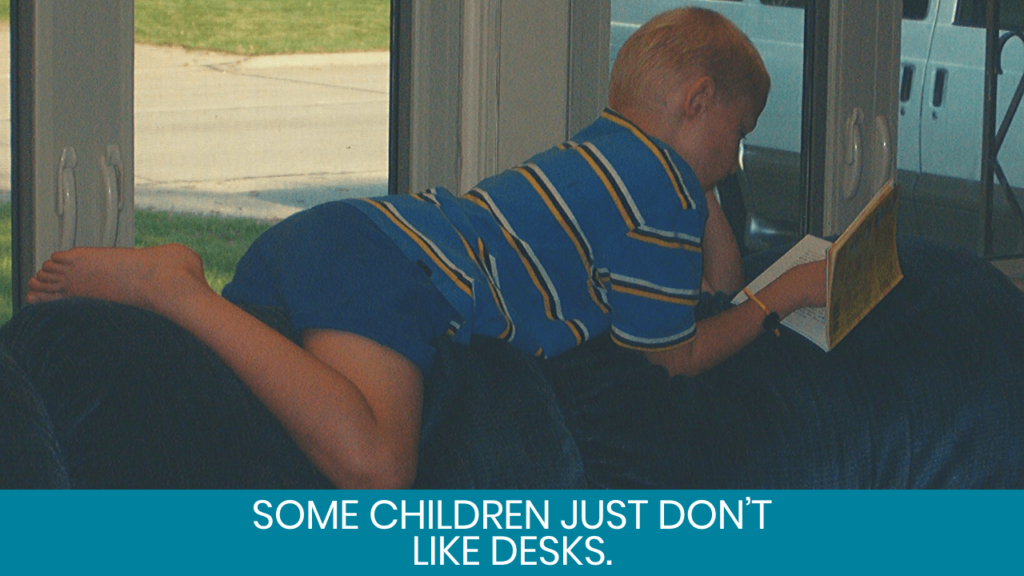This is the last part of a series of guest posts by Heather Weber, home-schooling veteran of over 20 years. Heather home-schooled her four children from birth through high school.
My favorite guide book for homeschooling, The Well-Trained Mind (WTM) by Jessie Wise and Susan Wise Bauer, includes learning stages, curriculum recommendations, and even advised amount of time the subject should take each week.
Notice I called it a guide book.
I love the premise of the book, and in the beginning of my homeschooling career I tried to follow the exact curriculum, including teaching Latin, and time plans. Though Jessie Wise had three children and I had four, I believed it was the best plan and truly gave it my all. We had a designated school table, the curriculum bought, and I smiled like a kid in a toy store as I purchased school supplies at the drug store that summer before Kindergarten.
And then God laughed.

Our Homeschool Struggles
My first child turned out to be borderline dyslexic, struggling to read until age nine. Since she had shown all the proper signs of being ready to read, we had started that struggle at age 4 ½. After using four different programs, blending words finally made sense.
During this time, homeschooling was still a blessing. I was able to keep her up to grade level on everything else because I read each page to her. She understood math problems easily, she just couldn’t read the words to herself. The WTM is heavy on dictation in the early years, sounding out the words I would read aloud, and she was to separate the phonics sounds out, pick the proper spelling and write the word. Obviously, that wasn’t working so well for us.
My second child was reading before my first mastered it. She devoured all books, but she was also not good at dictation. Years later we learned she was ADD not H. She would hide the workbooks and pretend not to know where they were. Sitting to do seat work was not going to work well for her.
My third child love to write. Dictation would have been easy for her, but by then I had chucked that idea out the window. I was reading so much out loud to the other two, I didn’t have the time to sit with just one anymore. My fourth, and only boy, was as busy a child as daughter #2, but as he played with his cars and Legos, he absorbed much more than I realized until later years.
The Lessons I’ve Learned
Two things all homeschooling parents learn quickly: roll with the punches, and you can’t do it all.
When your student for the day is feeling poorly the school books are pushed aside. It is not worth the homework battle when you know it will be much easier and faster to teach a healthy child. Even if they are not sick, there are times the child just needs a break.
Then there are days when life interrupts, and something in the house needs fixing. One benefit with homeschooling - the surprise field trip to the bank or auto mechanic. These are not lost school days, but times when the child learns about Real Life, a true benefit of homeschooling.
Your day will be filled with teaching your children, and running your business. Either of those on their own could fill a forty-hour work day, let alone trying to do both, and keep a house running. There will be days when one of those will take over the other, the dishes will not get washed, the laundry will not get folded, or the vacuum will not be run. Yet, you will want to be superwoman and do it all.
It is not possible.

How to Fit It All in a Day
The good news is there are many ways to cut the times needed for many activities or to blend them. The first step is to find ways to blend classes together. While reading and math skills truly need to be taught in a sequence as they build on the last lesson, science and history can be grouped.
All aged children can learn about the same time in history, or the same topic in science. Let’s say you read about Abraham Lincoln. An older child in sixth grade can then write a report about the president, while the younger first grader might build a log cabin out of any media available. Then at night, the read-aloud might be Magic Treehouse Civil War on Sunday, and Richard Peck’s A River Between Us.
Taxes due? The morning might be spent working on that paperwork, and the children get a free day or extra art/playdough time. If your students are older, they can help sort the receipts, or watch you enter your information into the computer budget program you use. Both ages will be learning the need to stay organized, the issues with taxes and how they apply, and all sorts of business information.
That laundry that has been piling up? Have a folding party with the children. Youngers can match socks, while middles can learn how to hang clothes. Need a trip to the grocery store? Turn it into a math lesson comparing prices and serving sizes.
The number of ways to blend learning with life, or otherwise adjusting, are endless. You just have to have patience for yourself and the children, and occasionally hire another teenager to help clean the house when you are hosting visitors for a dinner party.
At the end of it all ….
Learn to roll with the punches. Ask for help from your husband, children and others. Take it from me, a twenty-year veteran, with four successes launched into college and beyond, all the struggles are worth it. My children also know how to roll with the punches that life throws at them, and how to do their own laundry, too.
And the daughter who I wondered if I could ever teach her how to read? She is now teaching English in a foreign country.
Click the links to read Parts One and Two of this series.





